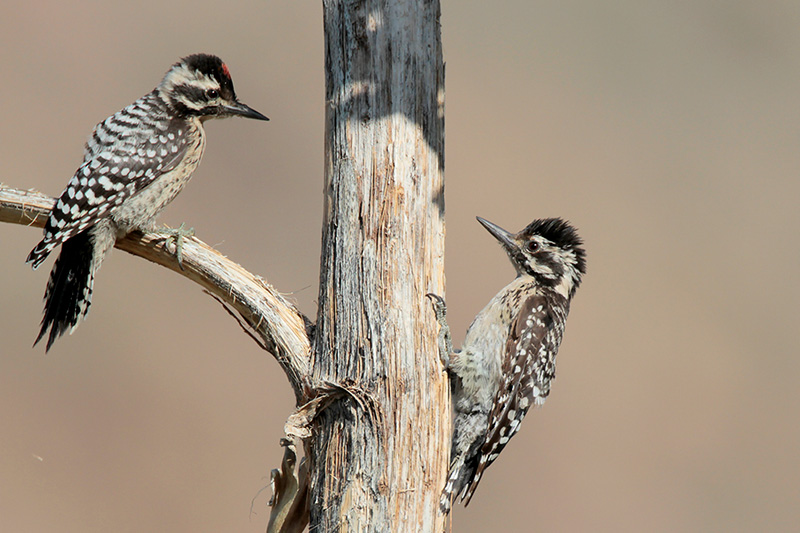
Woodpeckers are some of the more unique birds on the planet. With their bold plumage and laughing calls, these natural headbangers are appreciated in every birder’s backyard!
In most parts of North America, we are also lucky to have lots of common woodpecker species. However, some can look pretty similar and others only live in certain habitats. Do you wonder which woodpeckers visit your backyard? Which ones are making those laughing calls and tapping sounds noises in the neighborhood?
Find answers in this article detailing all of the types of woodpeckers in North America!
On this page
Types of Woodpeckers Found in the United States
Acorn Woodpecker (Melanerpes formicivorus)
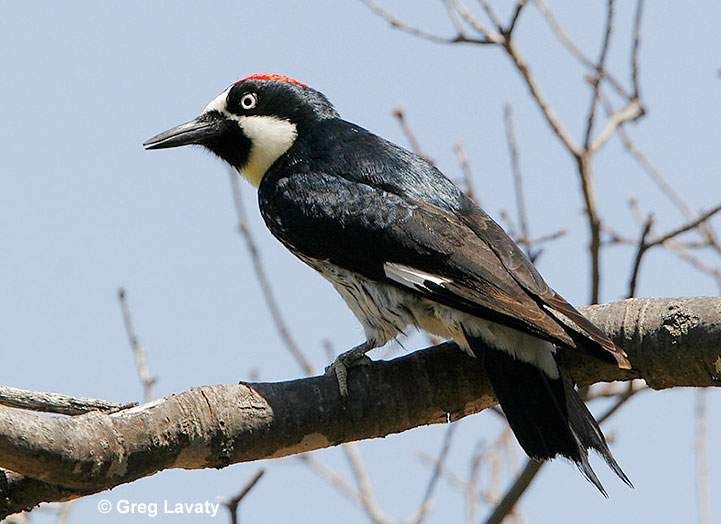
Size: 9 inches
Population trend: Increasing
Habitat: Oak and pine-oak woodlands in the western USA, Mexico, Central America, and Colombia.
Acorn Woodpeckers are beautiful woodpeckers with a clown-like black and white face and red patch on their head. They also have a black back, white rump, black chest patch and some black streaking on their pale underparts. Both sexes look alike, except males have a bigger red patch than females.
Related: Are there any blue woodpeckers?
In flight, Acorn Woodpeckers show a big white patch in each wing. These social birds can collect and store thousands of acorns!
American Three-toed Woodpecker (Picoides dorsalis)
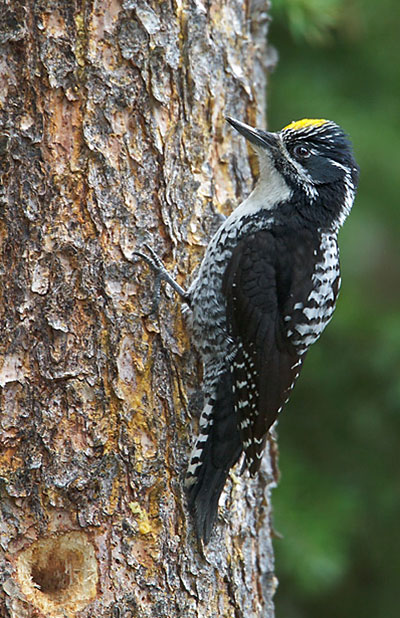
Photograph © Glenn Bartley
Size: 8.75 inches
Population trend: NA
Habitat: Mature spruce forests and high elevation forests in Alaska, Canada, parts of the northern USA, the Cascades, and in the Rocky Mountains.
American Three-toed Woodpeckers are black and white birds with diffuse barring on their underparts. They also have a white patch with some dark markings on their back. Both sexes look the same except that males have a dingy yellow patch on their head.
The American Three-toed Woodpecker is an uncommon species of mature forest, bogs, and remote areas. They sometimes occur in greater numbers in recently burned areas.
Arizona Woodpecker (Dryobates arizonae)
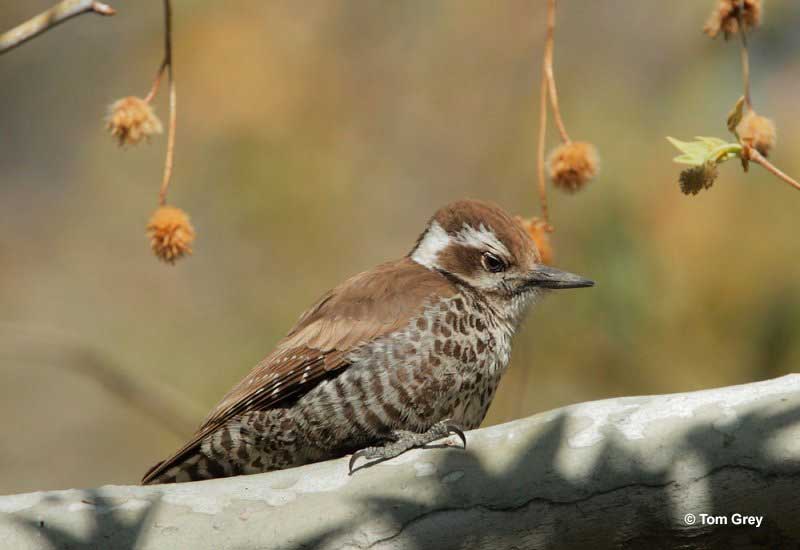
Size: 7.5 inches
Population trend: NA
Habitat: Dry, mid-elevation pine-oak woodlands in southeastern Arizona, adjacent New Mexico, and the mountains of western and central Mexico.
Arizona Woodpeckers are smallish woodpeckers with a dark brown back and a large white patch on each side of their neck. They also have brown spotting and barring on their underparts. Both sexes look alike except that males have a small red patch on their heads.
This species is the only woodpecker in North America with a plain, dark brown back. We often see this uncommon bird spiraling up one tree after another, often from the ground.
Black-backed Woodpecker (Picoides arcticus)
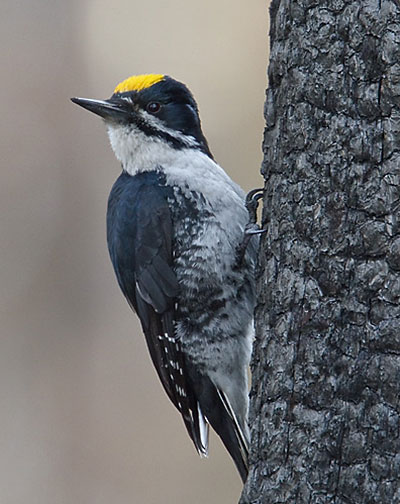
Male. Photograph © Glenn Bartley
Size: 9.5 inches
Population trend: NA
Habitat: Boreal and montane coniferous forests in Alaska, Canada, parts of the northern USA, and in the western USA south to Idaho and California. A population also lives in the Black Hills of South Dakota and adjacent Wyoming.
Black-backed Woodpeckers are medium-sized woodpeckers with black upperparts and diffuse but dense dark barring on their underparts. They also have a long, narrow white moustache mark. Both sexes are alike except that males have a bright yellow patch on their head.
This uncommon species pecks for wood-boring insects in forests, but especially in bogs and areas that have been burned or killed by insects.
The Black-backed Woodpecker and the related American Three-toed Woodpecker are the only woodpecker species in North America with three instead of four toes.
Downy Woodpecker (Dryobates pubescens)

Size: 6.75 inches
Population trend: Increasing in most areas.
Habitat: Second growth and young woodlands in southern Alaska, Canada, and most of the lower 48 states. It is absent from arid parts of Texas and much of the southwestern USA.
Downy Woodpeckers are small black and white woodpeckers, only a bit larger than a sparrow. They have short beaks, a black and white face, big white patch on their backs, white spotting in their wings, and white underparts.
Both sexes are alike, although males and juveniles have a small red patch on their heads. This familiar species is one of the most common woodpeckers in North America. A pair is usually present at any feeding station in their range.
Gila Woodpecker (Melanerpes uropygialis)
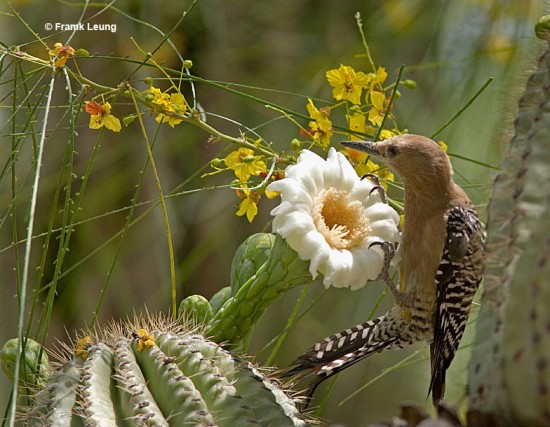
Size: 9.25 inches
Population trend: Declining in some areas.
Habitat: Deserts and other arid habitats in the southern half of Arizona, some parts of adjacent states, and northwestern Mexico.
Gila Woodpeckers are medium-sized woodpeckers nearly as big as an American Robin. They are gray-brown or tan-brown birds with bold black and white barred upperparts, and some black barring on their undertail.
They also have a hint of yellow on their belly. Both sexes are alike, although males have a red patch on their heads. This woodpecker is a common, bold species are easy to see in most of its range.
Gilded Flicker (Colaptes chrysoides)
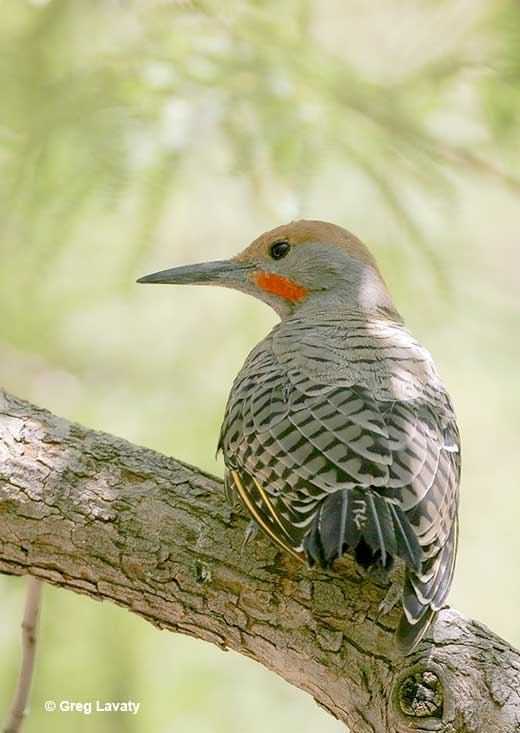
Size: 11 inches
Population trend: Declining
Habitat: Sonoran desert habitats, especially areas with mature Saguaro cacti in southern Arizona, southeastern California, and northwestern Mexico.
Gilded Flickers are big tan, buff and gray woodpeckers with pale brown on the top and back of their heads. They have a white rump, narrow black barring above, a black chest patch, and small black markings on the rest of their underparts.
Both sexes look the same except that males have a red mustache mark. In flight, this fancy desert bird shows bright yellow underwings. Gilded Flickers can be uncommon but are usually easy to see in places with lots of big Saguaro cactus.
Golden-fronted Woodpecker (Melanerpes aurifrons)
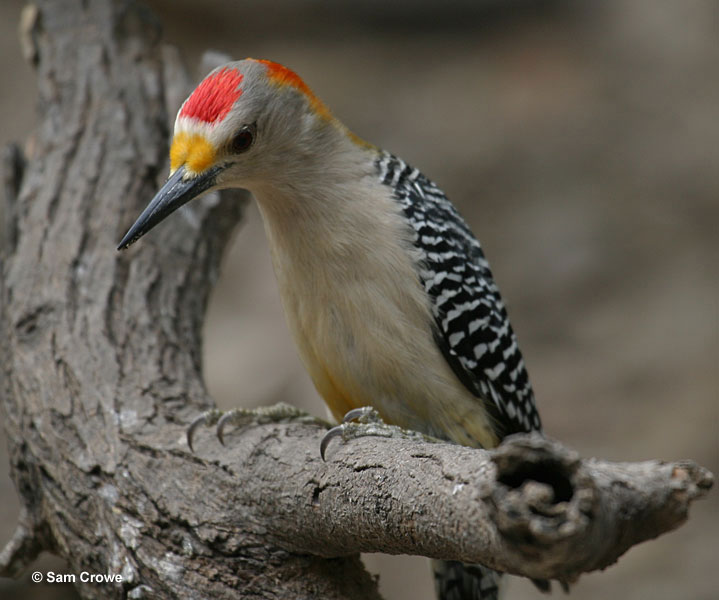
Size: 9.5 inches
Population trend: Increasing in some areas, declining in others.
Habitat: Various woodland and park-like habitats in Oklahoma, Texas, and many parts of Mexico and northern Central America.
Golden-fronted Woodpeckers are fair-sized birds nearly as big as an American Robin. They have long, sharp black beaks, and have pale, gray-brown heads with a yellow front and yellow nape.
These bold woodpeckers also have pale gray-brown underparts with some yellow on the belly, black spotting on their undertail, black tail, and black and white barred upperparts with a big white rump.
Both sexes are alike, except males have a red patch on their heads. Golden-fronted Woodpeckers are common, noisy, and conspicuous birds in most of their range.
Hairy Woodpecker (Dryobates villosus)
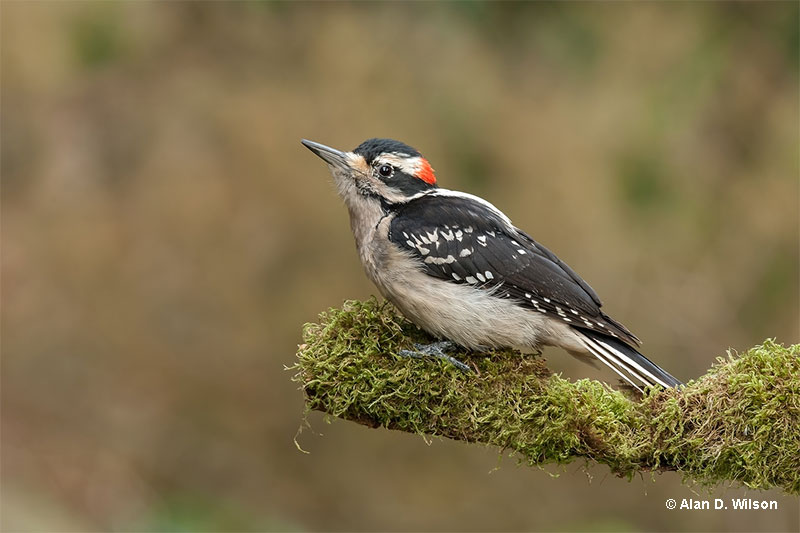
Size: 9.25 inches
Population trend: Increasing in most areas.
Habitat: Mature forests and woodlands with big trees in Alaska, Canada, most parts of the USA, and in montane forests from Mexico to Panama.
Hairy Woodpeckers are fair-sized black and white woodpeckers with a medium to long black beak and white underparts. They have a big white patch on their back, white spotting in their wings, and a black tail with pure white outer tail feathers.
Both sexes are alike except that males and juveniles have a small red patch on their heads. This species is most common in mature woodlands but can visit feeders. Hairy Woodpeckers are often confused with the extremely similar Downy woodpeckers but have longer beaks, sound different, and lack dark markings on their outer tail feathers.
Ladder-backed Woodpecker (Dryobates scalaris)
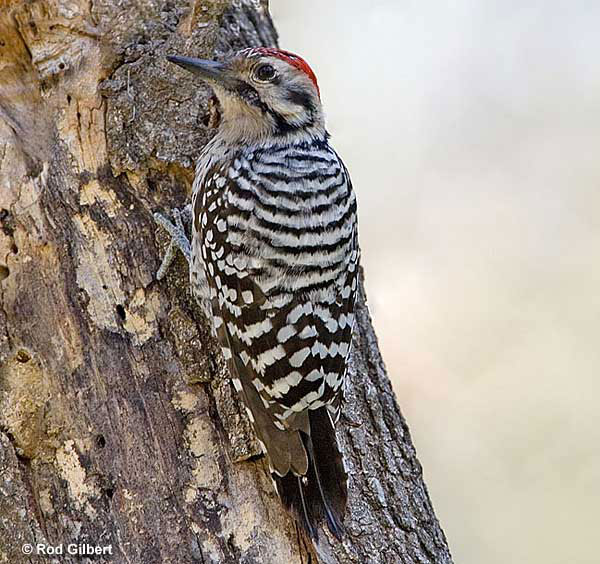
Size: 7.25 inches
Population trend: NA
Habitat: Deserts and arid scrubby habitats in the southwestern USA north to parts of eastern Colorado. It also lives in much of Mexico and parts of northern Central America.
Ladder-backed Woodpeckers are a small woodpecker species with black and white barred upperparts and small black markings on pale underparts. They also have two bold black lines on their pale face, a medium length beak, and black barring on their pale outer tail feathers.
Both sexes of the Ladder-backed Woodpecker are alike, except males and juveniles have a red patch on their head. On account of its habit of foraging in cactus, this small woodpecker used to be known as the “Cactus Woodpecker”. This species is common and easy to see in most of its range.
Lewis’s Woodpecker (Melanerpes lewis)
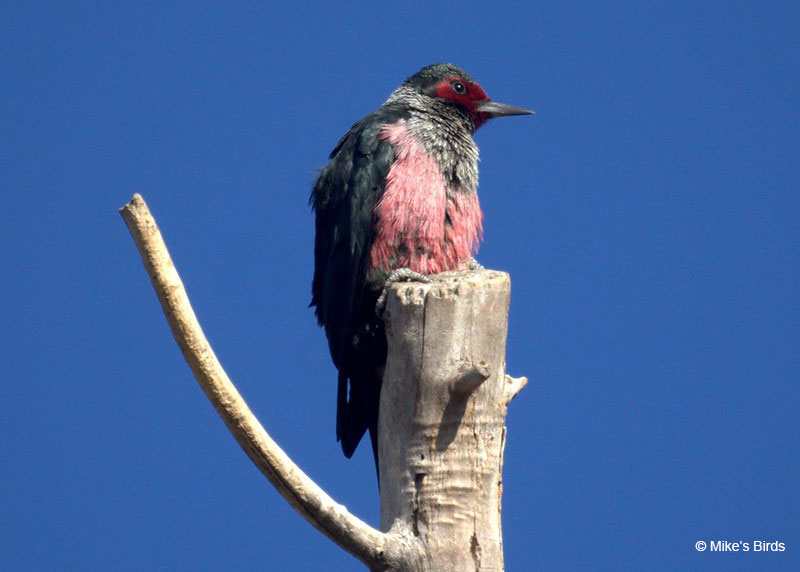
Size: 10.75 inches
Population trend: Declining
Habitat: Open Ponderosa Pine and other open woodland habitats with big, mature trees in southern British Columbia, and many parts of the western USA.
The Lewis’s Woodpecker is a big, unique woodpecker species of open western habitats. This unmistakable bird is blackish green with a pale, silvery-gray collar, breast, and sides. It also has a dark red face, and a dark pink belly.
Both sexes of the Lewis’s Woodpecker are alike, but juveniles are less colorful and have darker heads. I often see this species in floppy flight as it sallies from trees and posts to catch insects!
Northern Flicker (Colaptes auratus)

Size: 12.5 inches
Population trend: Declining in some regions.
Habitat: A wide variety of woodland, edge, and open habitats in eastern and southern Alaska, Canada, and throughout the lower 48 states. This species also lives in parts of the Caribbean and from Mexico to northern Central America.
Northern Flickers are big tan, buff, and gray woodpeckers with brown and gray heads, and black barring on pale brown upperparts. They have a black chest patch, small black markings on the rest of their buff underparts, and a bold white rump.
Western birds have red underwings and are known as Red-shafted Flickers, while eastern birds have yellow underwings and are called, Yellow-shafted Flickers.
Both sexes are similar, although males in the west have a red mustache mark and eastern males have a black mustache.
In most places, Northern Flickers are conspicuous and noisy birds frequently seen in flight over open areas, or perched on the ground as they forage for ants!
Did you know? Woodpeckers have long sticky tongues that help them catch food. Northern Flickers have the longest tongues!
Nuttall’s Woodpecker (Dryobates nuttallii)
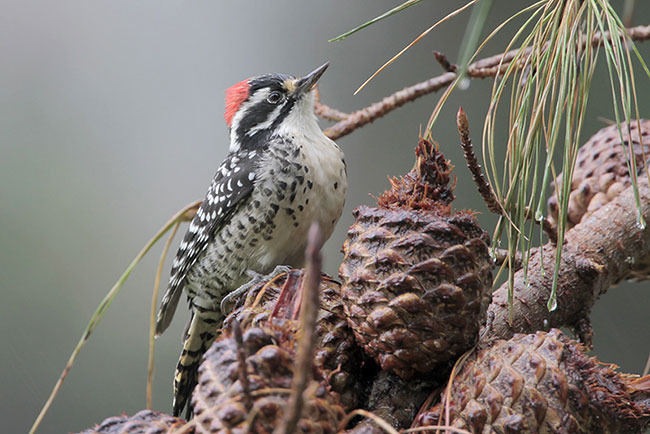
Size: 7.5 inches
Population trend: Increasing
Habitat: Oak woodlands in California and part of northern Baja California.
Nuttall’s Woodpeckers are small black and white woodpeckers nearly restricted to California. This species has thick black marks on its face, black and white barred upperparts with a black upper back, and some black spotting on the sides of its pale underparts.
Both sexes look alike, although males and juveniles have a red patch on their heads. They also have medium-length beaks that they use for pecking into the bark of oak trees. Although Nuttall’s Woodpeckers look similar to Ladder-backed Woodpeckers, the two species rarely come into contact.
Pileated Woodpecker (Dryocopus pileatus)
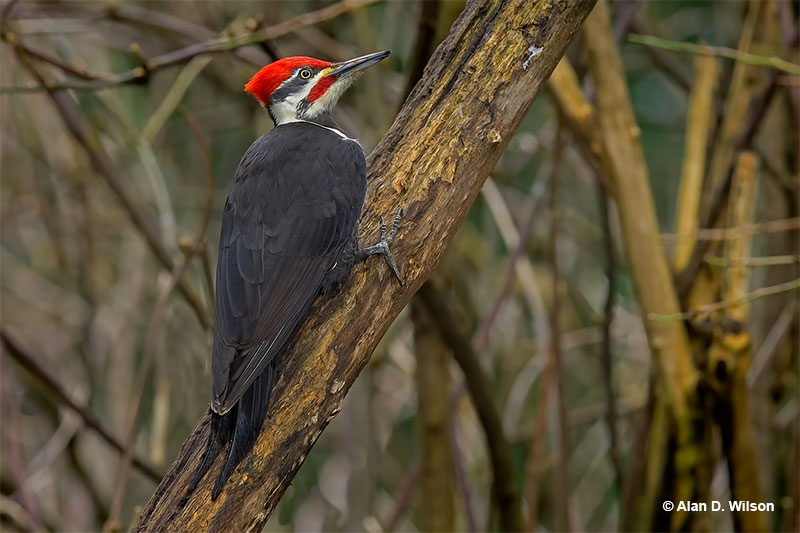
Size: 16.5 inches
Population trend: Increasing in most areas.
Habitat: Forests with big dead trees in large parts of central and southern Canada, the Pacific Northwest south to California, and much of the eastern USA.
The Pileated Woodpecker is a huge, impressive, crow-sized woodpecker with a prominent crest. It is mostly black with a black and white face, white throat, and white on each side of its neck. In flight, they show flashing white underwings and a small white patch on their upperwings.
Both sexes of the Pileated Woodpecker look similar, but males have more red on their heads. We usually see Pileated Woodpeckers in mature woodlands, but in some places, this spectacular bird also visits feeders!
Red-bellied Woodpecker (Melanerpes carolinus)
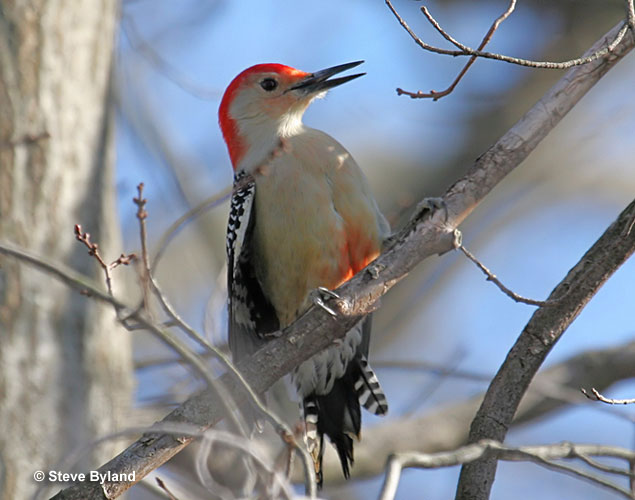
Size: 9.25 inches
Population trend: Increasing
Habitat: Various forest, woodland, and park-like habitats in parts of southeastern Canada and the eastern USA.
Red-bellied Woodpeckers are medium-sized woodpeckers with a longish, sharp black beak, and a pale gray-brown head with a red nape, and small reddish-orange front. They also have black and white barred upperparts, a white rump with some dark markings, and some dark markings on their undertail.
The rest of their underparts are pale gray-brown with a small red patch on their belly. Both sexes of the Red-bellied Woodpecker look alike, but males have more red on their heads. This aggressive and conspicuous species visits feeders and has become a common bird in many urban areas.
Red-breasted Sapsucker (Sphyrapicus ruber)
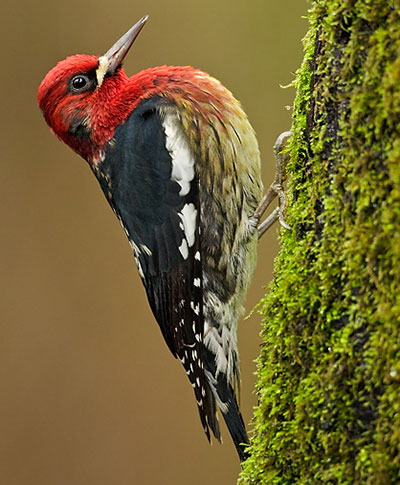
Photograph © Glenn Bartley
Size: 8.5 inches
Population trend: Increasing in some areas.
Habitat: Forest habitats in Pacific western North America from southern Alaska and British Columbia to California and adjacent Baja California.
The Red-breasted Sapsucker is a beautiful woodpecker that mostly lives in the cool, wet woodlands of the Pacific Northwest. It has a red head and breast, a small white patch on its face, and some fine dark markings on its pale yellow belly.
This species also has black upperparts with a narrow white rump, some white markings on its back, and a white patch on each wing. Both sexes are similar, but females have more white on their faces. Like other sapsucker species, the Red-breasted also taps holes in trees to feed on sap.
Red-cockaded Woodpecker (Drobates borealis)
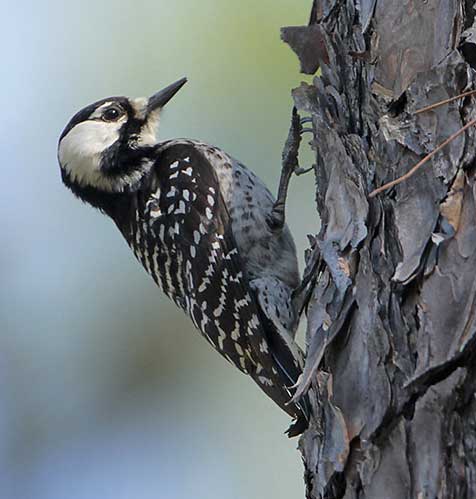
Female Red Cockaded Woodpecker. © Greg Lavaty
Size: 8.5 inches
Population trend: Declining
Habitat: Mature, open Longleaf Pine forests that experience fires on a regular basis in the southeastern USA.
Red-cockaded Woodpeckers are small to medium-sized, black and white woodpeckers with fairly short beaks. They have a large white area on each side of their head and white barring on their black backs. This species also has some black spots and bars on its white underparts.
Both sexes are alike, except males have a tiny red spot on the back of their heads. The Red-cockaded Woodpecker is an uncommon, threatened species that requires fire and other types of forest management. Their habitats are scattered across Georgia, Florida, Virginia, Oklahoma, and Texas.
Red-headed Woodpecker (Melanerpes erythocephalus)
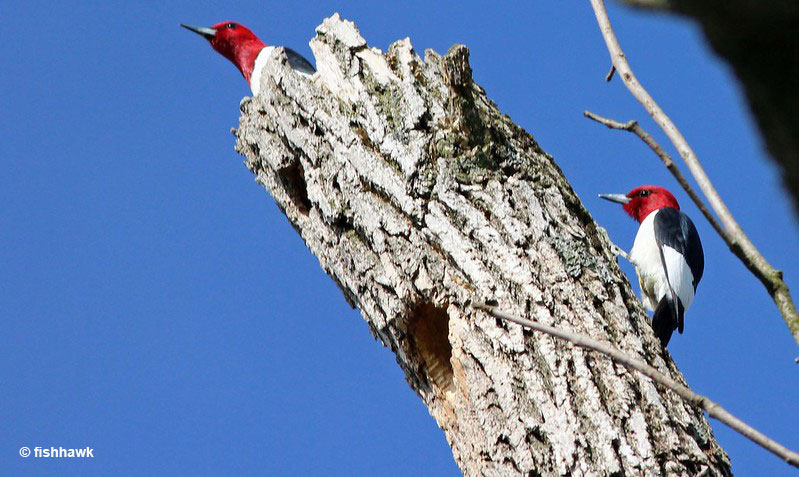
Size: 9.25 inches
Population trend: Declining
Habitat: Oak savannahs, golf courses, woodlands, and other open and semi-open habitats with big dead trees.
The Red-headed Woodpecker is a striking, beautiful, medium-sized woodpecker with a longish, sharp gray beak. Both sexes look the same and have a velvety-red head and white underparts. They also have glossy black upperparts with a big white rump and lower back, and big white wing patches.
Juveniles share this plumage pattern but have gray-brown heads. I usually see Red-headed Woodpeckers perched high on a snag or sallying out over open areas to catch insects in flight.
Red-naped Sapsucker (Sphyrapicus nuchalis)
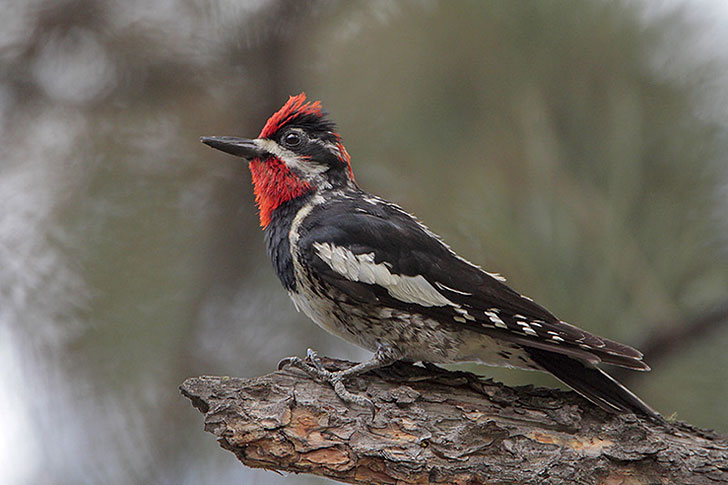
Size: 8.5 inches
Population trend: NA
Habitat: Woodlands in and near the Rocky Mountains from British Columbia and Alberta to Arizona. In the winter, it also occurs at lower elevations and south to central Mexico.
Red-naped Sapsuckers are striking, medium-sized, black and white woodpeckers with a narrow white patch on each wing, a red crown, and a small red spot on the back of their head. They have a black and white face with a bold white line extending from their beak to their neck and a red throat. This species also has a pale yellow belly and fine black markings on its pale sides.
Both sexes of the Red-naped Sapsucker are similar, except that males have more red on their heads and females also have more white on their faces. This handsome woodpecker sometimes hybridizes with Red-breasted Sapsuckers in the western part of its range.
White-headed Woodpecker (Drobates albolarvatus)
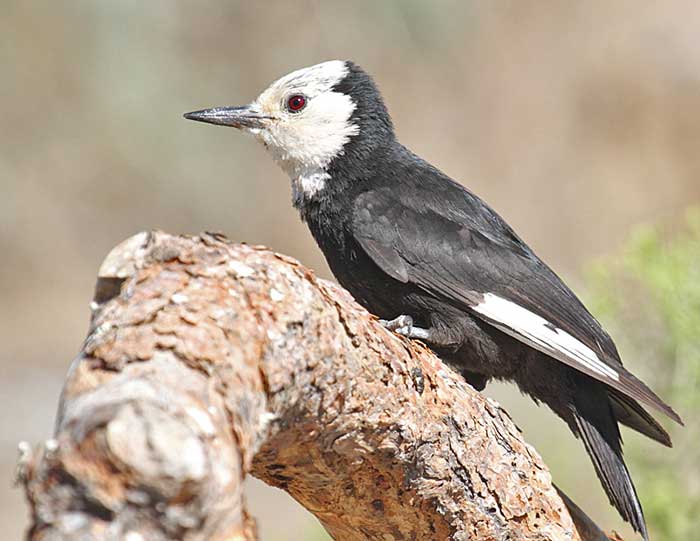
Size: 9.25 inches
Population trend: Increasing
Habitat: Montane forests with lots of pine trees in parts of the Pacific Northwest south to California. A tiny population also persists in southern British Columbia.
The White-headed Woodpecker is a distinctive, medium-sized woodpecker of western mountain ranges.
This striking woodpecker is black with bone-white on its face, throat, and the top of its head. It also has a white patch on each of its wings.
Both sexes of the White-headed Woodpecker look similar, but males and juveniles have a small red patch on their head. This uncommon species is local and often nests just ten feet above the ground in trees killed by fire.
Williamson’s Sapsucker (Sphyrapicus thyroideus)
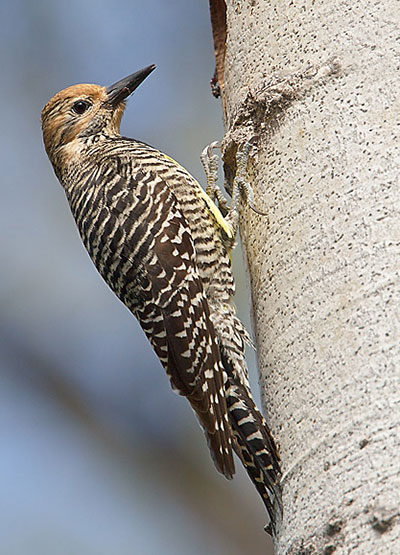
Size: 9 inches
Population trend: NA
Habitat: Montane coniferous and mixed coniferous/deciduous forests in southern British Columbia, and mountain ranges in the western USA. In winter, they also occur in woodlands at lower elevations and in montane forests in Mexico.
Williamson’s Sapsuckers are striking, medium-sized woodpeckers with yellow bellies, a black chest, and a white rump. Males are black with two narrow white lines on their head, a red throat, and a white patch on each wing.
Female Williamson’s Sapsuckers are very different and have brownish heads, dark markings on their sides, and fine pale bars on their upper parts.
No other woodpecker species has such differently plumaged males and females. In summer, we usually find this beautiful bird in drier areas of forest with Larch, often below ridgelines.
Yellow-bellied Sapsucker (Sphyrapicus varius)
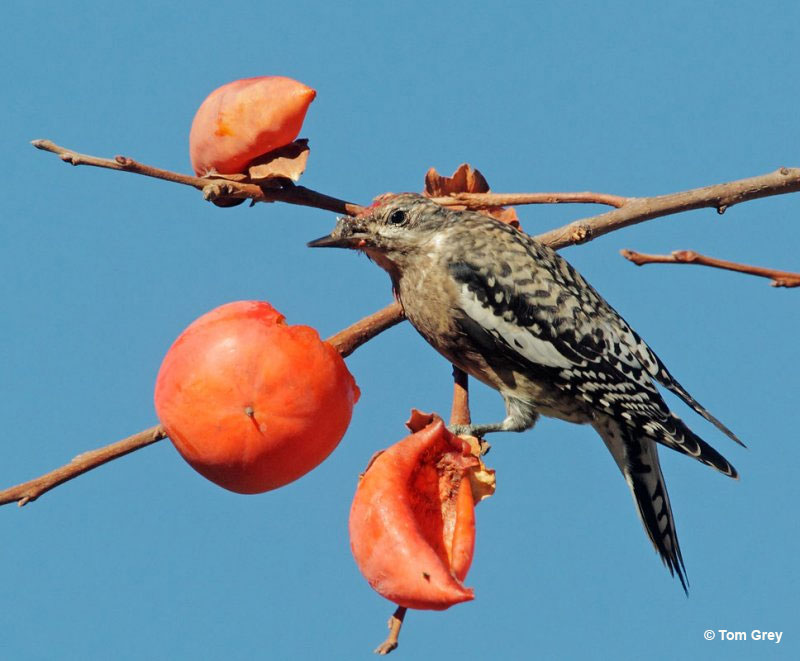
Size: 8.5 inches
Population trend: Declining in some areas.
Habitat: Young forests and riparian zones in Canada, and the northeastern USA from North Dakota east to Maine and south in the Appalachians to West Virginia. In winter, we can also find them in woodlands in much of the southeastern USA (but up in the north, too, like in Ohio), Mexico, the Caribbean, and Central America.
Yellow-bellied Sapsuckers are medium-sized, black and white woodpeckers with a yellow belly, red crown, and a black patch on their chest. They have a thick white line that goes from their bill back to and down their neck, black and white barring on their backs, and some small black markings on their sides. This species also has a white patch on each of its wings.
Both sexes are similar except that males have a red throat bordered by black. Ruby-throated Hummingbirds often drink sap from small holes in trees made by the woodpecker.
Possibly Extinct
Ivory-billed Woodpecker (Campephilus principalis)
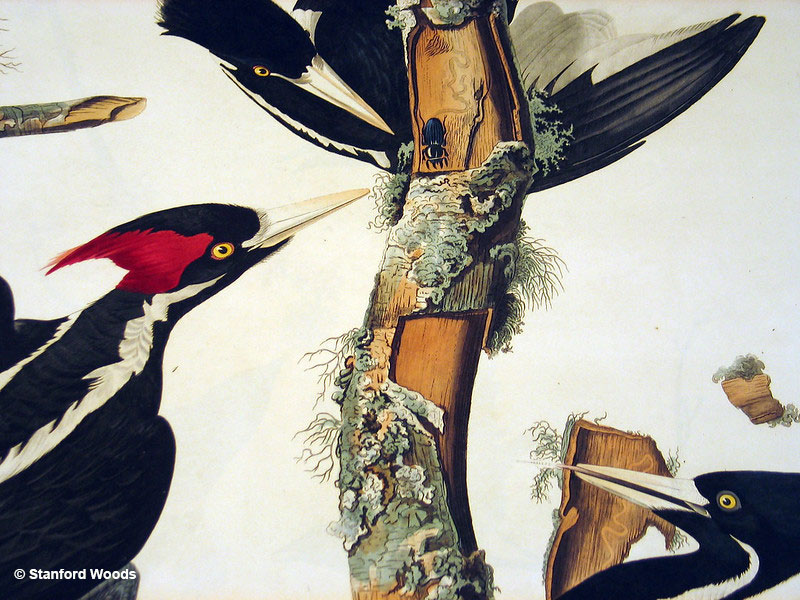
Size: 19 inches
Population trend: Presumed extinct
Habitat: Large areas of old growth cypress swamp forest in the southeastern USA.
The Ivory-billed Woodpecker is a huge woodpecker, even bigger than the Pileated Woodpecker! This magnificent, crested bird is jet black with a long white beak and has a white line on each side of its neck. It also has two white lines on its back, and a big white patch on the secondaries (or trailing edge) of each wing.
Male Ivory-billed Woodpeckers also have a red crest, while females have a black, more flared crest.
Sadly, deforestation and other factors eliminated this spectacular type of woodpecker and it is extinct or close to extinction.
Types of Woodpeckers – FAQ’s
What do woodpeckers eat?
Woodpeckers eat grubs and other insects that they peck out of branches, trees, and other vegetation. Many species also eat nuts, seeds, and fruit. On occasion, woodpeckers can also prey on the eggs and young of other birds.
Why do woodpeckers peck?
Woodpeckers peck to find food and to show other woodpeckers where their territory is.
Why don’t woodpeckers get concussions?
Woodpeckers don’t get concussions because they have thick neck muscles and specialized bones that cushion and protect their brain.
What does a woodpecker symbolize?
A woodpecker symbolizes opportunity, independence, and determination.

